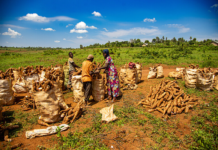
More than 12,000 small and medium scale farmers across Uganda are set to benefit from a Danish government funded postpaid irrigation systems project launched in Kampala yesterday.
The project dubbed ‘Enhancing Irrigation to Improve Climate Adaptation and Sustain Smallholder Production Systems in Uganda’ will see the farmers trained on using irrigation technology to ensure food production all year round.
Through the Danish International Development Agency (DANIDA) Green Business Partnership Program, the Danish government has allocated up to USD 1.5 million for the 3-year project.
It will be implemented by East Africa Grain Council (Uganda), Grundfos (Denmark), Akvo International (Uganda) and Access to Innovation (Denmark)with support from the Denmark Ministry of Foreign Affairs.
According to Mr. John McNay, the East Afican Advisor for Access to Innovation, Danish organisation operating in East Africa, the project is to ensure that farmers adopt quality climate-smart irrigation technologies bearing the current climate change effects.
“In fact, farmers in Uganda are experiencing increased crop failure as a result of climate change shocks hence irrigation is going toplay an important role going into the future not only for the high values crops but also for the lower value ones,” said McNay.
Project focus
Gerald Masila, the Executive Director of the Eastern Africa Grain Council (EAGC), highlights that in addition to cereals, the project intends to focus on irrigating high-value crops. This strategy is designed to ensure greater profitability for farmers, given the availability of a ready market.
“The project welcomes participation from farmers across the country, provided they are members of recognized farmers’ organizations. These organizations will facilitate the application process for accessing the technology,” explained Masila.
Large-scale farmers will also have an opportunity to participate in a distinct manner, showing their interest and applying accordingly.
The availability of a water source to support irrigation is a critical criterion before the equipment is provided, as emphasized by Masila. “Under this project, farmers can utilize the irrigation tools without upfront payments.”
The off-taker arrangement, where farmers use the equipment and make payments after production, addresses the common concern of affordability associated with high-quality solar-powered irrigation systems among farmers, according to the CEO.
“In contrast to other projects, our approach is unique. We’re developing a business plan that considers the equipment acquisition cost, the projected yield, and a pre-identified off-taker with an established price. This way, the technology’s cost is factored in based on the expected income from the produce.”
Masila also noted that in case the yield is insufficient to cover the loan, a mechanism has been put in place to handle such situations, which is one of EAGC’s roles in the consortium.
Business plan
According to McNay, a business plan is being developed that will consider equipment cost, the projected yield, and a pre-identified off-taker with an established price.
In this, the technology’s cost will be factored in based on the expected income from the produce.
“Other than helping the farmers draw the business plan, we will also support them develop value chains so that besides growing better crops under irrigation, they can also fin market for their produce in Scandinavian markets,” he said.
Joshua Enyati, the Agricultural Irrigation Engineer at Akvo International Uganda, highlights that the project’s installation is demand-driven and tailored to individual farmers’ requirements.
“The installation process involves farmers making requests, and the available funds can support up to 12,000 farmers,” said Enyati.







